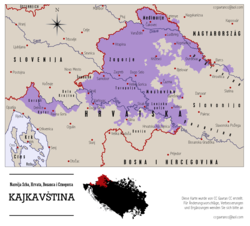This article has multiple issues. Please help improve it or discuss these issues on the talk page . (Learn how and when to remove these messages)
|

The dialects of Serbo-Croatian include the vernacular forms and standardized sub-dialect forms of Serbo-Croatian as a whole or as part of its standard varieties: Bosnian, Croatian, Montenegrin, and Serbian. They are part of the dialect continuum of South Slavic languages [1] [2] that joins through the transitional Torlakian dialects the Macedonian dialects to the south, Bulgarian dialects to the southeast and Slovene dialects to the northwest. [3]
Contents
- Main dialects
- Shtokavian dialects
- Chakavian dialects
- Kajkavian dialects
- Comparative analysis
- Torlakian dialects
- Other varieties
- Burgenland Croatian
- Molise Slavic
- Division by jat reflex
- See also
- References
- Bibliography
- Further reading
The division of South Slavic dialects to "Slovene", "Serbo-Croatian", "Macedonian" and "Bulgarian" is mostly based on political grounds: for example all dialects within modern Slovenia are classified as "Slovene", despite some of them historically originating from other regions, while all dialects in modern Croatia are classified as "Croatian" (or "Croato-Serbian" before 1990) despite not forming a coherent linguistic entity (and some are proven to originate from parts of what is today Slovenia). Therefore, "Serbo-Croatian dialects" are simply South Slavic dialects in countries where a variant of Serbo-Croatian is used as the standard language. [3] [4] However, in broad terms, the Eastern South Slavic dialects differ most from the Western South Slavic dialects.
The primary dialects are named after the most common question word for what: Shtokavian (štokavski) uses the pronoun što or šta, Chakavian (čakavski) uses ča or ca, Kajkavian (kajkavski), kaj or kej. The pluricentric Serbo-Croatian standard language and all four contemporary standard variants are based on the Eastern Herzegovinian subdialect of Neo-Shtokavian. [5] [6] [7] The other dialects are not taught in schools or used by the state media. The Torlakian dialect is often added to the list, though sources usually note that it is a transitional dialect between Shtokavian and the Bulgaro-Macedonian dialects. Burgenland Croatian and Molise Slavic are varieties of the Chakavian dialect spoken outside the South Slavic dialect continuum, which combine influences from other dialects of Serbo-Croatian as well as influences from the dominantly spoken local languages.
Another frequently-noted distinction among the dialects is made through the reflex of the long Common Slavic vowel jat ; the dialects are divided along Ikavian, Ekavian, and Ijekavian isoglosses, with the reflects of jat being /i/, /e/, and /ije/ or /je/ respectively.



